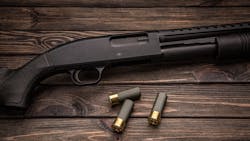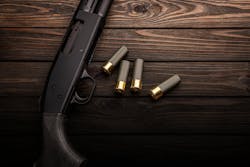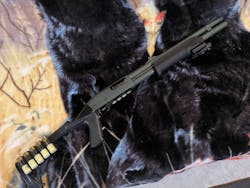The Value of Shotgun Versatility
As we discuss shotguns for law enforcement use and take a look at the value of the versatility available, it’s important to also consider the variety of ammunition selection and the added versatility that such offers. Let’s start out taking a look at the dominant shotgun designs today and, for the sake of simplicity, restrict our conversation to the 12 gauge, which is the most common caliber used in shotguns.
This article appeared in the July issue of OFFICER Magazine. Click Here to view the digital edition. Click Here to subscribe to OFFICER Magazine.
In the past four to five decades there have been a few dominant manufacturers and models of pump action shotguns. There is also an assortment of semi-automatic shotguns that have been and continue to be used. Notably, Remington, Mossberg, Smith & Wesson, Ithaca and others have manufactured shotguns. Smith & Wesson stopped manufacturing shotguns some time back but they were not significantly different from the Mossberg 500. The dominant pump action shotguns today are arguably the Remington 870 and the Mossberg 500/590. The biggest/easiest to note difference between the two is the safety location: Remington’s is behind the trigger while the Mossberg is atop the rear of the receiver.
Thanks to the age of the general shotgun design, it can affectionately be referred to as a modular weapon. The shoulder stock, fore end, magazine tube and more can all be modified or traded out. The sights have run the gamut from just a front bead to rifle sights to picatinny rail supporting optics. Fore ends are available that incorporate light or offer picatinny rail to mount lights and lasers if you’d prefer. Shotguns are sold with magazine tubes that run from three-round capacity to seven-round capacity and if yours is on the lower end you can buy a magazine tube extension to increase your capacity. Want even more rounds available? Several companies make “side saddle” shotshell holders that mount on the side of the receiver or stock.
The shoulder stock can be switched out so you can have a fixed stock, an adjustable stock or just a pistol grip if you’d prefer—and dependent on the intended purpose of the weapon. The same thing actually applies to the barrel length—which also limits your magazine tube length to some extent. Remembering that you have to stay in compliance with all state and federal laws, if you’re building a breaching shotgun you can have a shorter barrel, pistol grip, short magazine tube and bead front sight (or no sights if you’re simply putting the gun close to hinges/door locks).All of these options let you build your shotgun the way you want it to be to suit your intended purpose. Adding to the versatility of the shotgun is the variety of ammo available for it. While most early shotguns had a 2.75” chamber, limiting you to such ammo, most of today’s have a 3” or 3.5” chamber granting you a greater choice of load types. Sticking to the 2.75” ammo you have everything available from slug to sabot (smaller slug in a plastic delivery sleeve that peels off on exiting the muzzle) to shot shells. The shot size can range from 00- to 12-shot but law enforcement doesn’t have much use for anything smaller than 4-shot, and even then only for dealing with rabid or vicious animals. When you add up the design variety you can create from all the options and then multiply that by the types of ammo available, the versatility of the shotgun simply can’t be matched by any other common weapon in the law enforcement arsenal today.
One purpose we haven’t discussed yet is the dedicated less-lethal shotgun. I am never a fan of mixed-purpose weapons. Dedicate it to lethal use or less-lethal use but pick one and stick with it. Nothing good comes of putting less-lethal ammo in a lethal use shotgun “just for the mission.”
Most agencies who dedicate a less-lethal shotgun do so by equipping it with neon/blaze orange stock and fore end. It may further have “Less-Lethal Only” labeled on each side of the receiver. Such dedicated shotguns should only ever be loaded with less-lethal ammo, but worry not—there is quite the variety of less-lethal ammunition you can choose from dependent on your need.
As a relatively small sample what types of less-lethal ammo you can get, just from ALS Less Lethal alone, there are 17 different types. The most commonly used are most likely the Hydro-Kinetic Impact bag, the Rubber Fin Rocket, The Hornets Next .32 Cal. Rubber Balls, the Tri-Dent .69 Cal. Rubber Balls, muzzle blast, aerial warning bangs and more. OC Blast cartridges, Stabilized bean bag rounds, Rubber fin rocket rounds equipped with CS or OC loads are available. And for those of you who are sure the terminator robots are coming to visit at some point, you can even get SkyNet Drone Defense rounds.
The Lightfield Ammunition Corporation is another company that offers nine different types of less-lethal ammo to include rubber star loads (Starlite, HV Stare and Superstar), Intermediate Range Rubber Slug Midrange Double Ball, High Velocity Rubber Buckshot, Nova Distraction Round and a couple breaching round variants.
That’s just two companies that manufacture less-lethal ammo and when you look at it—some 26 different types of less lethal ammo—you once again see the extreme versatility of the shotgun dependent on the needs of the agency and officers assigned. As mentioned earlier with lethal ammo, when you start doing simple math on all of the different builds you can get for a shotgun system and then start multiplying in the types of lethal ammo, or switch the gun to dedicated less-lethal and do the math there, the options and possibilities are staggering. With that thought in mind, we ask this: Why are shotguns being removed from the law enforcement arsenal in such wide numbers? Yes, patrol rifles are necessary, but they are not the end-all, be-all. The versatility of the shotgun should ensure it’s place in your arsenal and patrol vehicle.
This article appeared in the July issue of OFFICER Magazine.
About the Author
Lt. Frank Borelli (ret), Editorial Director
Editorial Director
Lt. Frank Borelli is the Editorial Director for the Officer Media Group. Frank brings 20+ years of writing and editing experience in addition to 40 years of law enforcement operations, administration and training experience to the team.
Frank has had numerous books published which are available on Amazon.com, BarnesAndNoble.com, and other major retail outlets.
If you have any comments or questions, you can contact him via email at [email protected].




